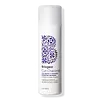What's inside
What's inside
 Key Ingredients
Key Ingredients

 Benefits
Benefits

 Concerns
Concerns

 Ingredients Side-by-side
Ingredients Side-by-side

Water
Skin ConditioningDecyl Glucoside
CleansingSodium Lauroyl Lactylate
EmulsifyingParfum
MaskingGlycerin
HumectantGuar Hydroxypropyltrimonium Chloride
Skin ConditioningPanthenol
Skin ConditioningHydrolyzed Rice Protein
Skin ConditioningButyrospermum Parkii Butter
Skin ConditioningRicinus Communis Seed Oil
MaskingMauritia Flexuosa Fruit Oil
Skin ConditioningNiacin
SmoothingHydrolyzed Wheat Protein
Skin ConditioningMentha Piperita Leaf Extract
Skin ConditioningAcetic Acid
BufferingYeast Extract
Skin ConditioningHydrolyzed Wheat Starch
Skin ConditioningHydrolyzed Keratin
HumectantGlycine Soja Oil
EmollientTocopherol
AntioxidantAloe Barbadensis Leaf Juice
Skin ConditioningTrifolium Pratense Flower Extract
AstringentCaramel
Cosmetic ColorantCaprylyl Glycol
EmollientCaprylhydroxamic Acid
Potassium Sorbate
PreservativeSodium Benzoate
MaskingWater, Decyl Glucoside, Sodium Lauroyl Lactylate, Parfum, Glycerin, Guar Hydroxypropyltrimonium Chloride, Panthenol, Hydrolyzed Rice Protein, Butyrospermum Parkii Butter, Ricinus Communis Seed Oil, Mauritia Flexuosa Fruit Oil, Niacin, Hydrolyzed Wheat Protein, Mentha Piperita Leaf Extract, Acetic Acid, Yeast Extract, Hydrolyzed Wheat Starch, Hydrolyzed Keratin, Glycine Soja Oil, Tocopherol, Aloe Barbadensis Leaf Juice, Trifolium Pratense Flower Extract, Caramel, Caprylyl Glycol, Caprylhydroxamic Acid, Potassium Sorbate, Sodium Benzoate
Water
Skin ConditioningLauramidopropyl Betaine
CleansingSodium Cocoyl Isethionate
CleansingGlycerin
HumectantGlycol Distearate
EmollientCocamidopropyl Hydroxysultaine
CleansingDisodium Laureth Sulfosuccinate
CleansingButyrospermum Parkii Butter
Skin ConditioningOryza Sativa Extract
AbsorbentRice Amino Acids
Skin ConditioningLactobacillus/Tomato Fruit Ferment Extract
Skin ConditioningPersea Gratissima Oil
Skin ConditioningRosa Canina Fruit Oil
EmollientAcanthus Mollis Leaf Extract
Skin ConditioningTocopheryl Acetate
AntioxidantAloe Barbadensis Leaf Juice
Skin ConditioningKeratin Amino Acids
Skin ConditioningCoconut Acid
CleansingHydrolyzed Quinoa
Skin ConditioningSodium Hyaluronate
HumectantAcyl Coenzyme A Desaturase
Skin ConditioningCitrus Aurantium Dulcis Peel Oil
MaskingCitrus Paradisi Peel Oil
MaskingPolyquaternium-71
HumectantSodium Lauryl Sulfoacetate
CleansingLeuconostoc/Radish Root Ferment Filtrate
AntimicrobialSodium Lauroyl Sarcosinate
CleansingSodium Isethionate
CleansingPolyquaternium-7
Anhydroxylitol
HumectantXylitylglucoside
HumectantXylitol
HumectantParfum
MaskingDehydroacetic Acid
PreservativeBenzyl Alcohol
PerfumingWater, Lauramidopropyl Betaine, Sodium Cocoyl Isethionate, Glycerin, Glycol Distearate, Cocamidopropyl Hydroxysultaine, Disodium Laureth Sulfosuccinate, Butyrospermum Parkii Butter, Oryza Sativa Extract, Rice Amino Acids, Lactobacillus/Tomato Fruit Ferment Extract, Persea Gratissima Oil, Rosa Canina Fruit Oil, Acanthus Mollis Leaf Extract, Tocopheryl Acetate, Aloe Barbadensis Leaf Juice, Keratin Amino Acids, Coconut Acid, Hydrolyzed Quinoa, Sodium Hyaluronate, Acyl Coenzyme A Desaturase, Citrus Aurantium Dulcis Peel Oil, Citrus Paradisi Peel Oil, Polyquaternium-71, Sodium Lauryl Sulfoacetate, Leuconostoc/Radish Root Ferment Filtrate, Sodium Lauroyl Sarcosinate, Sodium Isethionate, Polyquaternium-7, Anhydroxylitol, Xylitylglucoside, Xylitol, Parfum, Dehydroacetic Acid, Benzyl Alcohol
Ingredients Explained
These ingredients are found in both products.
Ingredients higher up in an ingredient list are typically present in a larger amount.
Aloe Barbadensis Leaf Juice comes from leaves of the aloe plant. Aloe Barbadensis Leaf Juice is best known for helping to soothe sunburns. It is also anti-inflammatory, moisturizing, antiseptic, and can help heal wounds.
Aloe is packed with good stuff including Vitamins A, C, and E. These vitamins are antioxidants, which help fight free-radicals and the damage they may cause. Free-radicals are molecules that may damage your skin cells, such as pollution.
Aloe Barbadensis Leaf Juice also contains sugars. These sugars come in the form of monosaccharides and polysaccharides, folic acid, and choline. These sugars are able to help bind moisture to skin.
It also contains minerals such as calcium, 12 anthraquinones, fatty acids, amino acids, and Vitamin B12.
Learn more about Aloe Barbadensis Leaf JuiceThis ingredient is also known as shea butter. It is an effective skin hydrator and emollient.
Emollients help soothe and soften your skin. It does this by creating a protective film on your skin. This barrier helps trap moisture and keeps your skin hydrated. Emollients may be effective at treating dry or itchy skin.
Shea butter is rich in antioxidants. Antioxidants help fight free-radicals, or molecules that may harm the body. It is also full of fatty acids including stearic acid and linoleic acid. These acids help replenish the skin and keep skin moisturized.
While Shea Butter has an SPF rating of about 3-4, it is not a sunscreen replacement.
Shea butter may not be fungal acne safe. We recommend speaking with a professional if you have any concerns.
Learn more about Butyrospermum Parkii ButterGlycerin is already naturally found in your skin. It helps moisturize and protect your skin.
A study from 2016 found glycerin to be more effective as a humectant than AHAs and hyaluronic acid.
As a humectant, it helps the skin stay hydrated by pulling moisture to your skin. The low molecular weight of glycerin allows it to pull moisture into the deeper layers of your skin.
Hydrated skin improves your skin barrier; Your skin barrier helps protect against irritants and bacteria.
Glycerin has also been found to have antimicrobial and antiviral properties. Due to these properties, glycerin is often used in wound and burn treatments.
In cosmetics, glycerin is usually derived from plants such as soybean or palm. However, it can also be sourced from animals, such as tallow or animal fat.
This ingredient is organic, colorless, odorless, and non-toxic.
Glycerin is the name for this ingredient in American English. British English uses Glycerol/Glycerine.
Learn more about GlycerinParfum is a catch-all term for an ingredient or more that is used to give a scent to products.
Also called "fragrance", this ingredient can be a blend of hundreds of chemicals or plant oils. This means every product with "fragrance" or "parfum" in the ingredients list is a different mixture.
For instance, Habanolide is a proprietary trade name for a specific aroma chemical. When used as a fragrance ingredient in cosmetics, most aroma chemicals fall under the broad labeling category of “FRAGRANCE” or “PARFUM” according to EU and US regulations.
The term 'parfum' or 'fragrance' is not regulated in many countries. In many cases, it is up to the brand to define this term.
For instance, many brands choose to label themselves as "fragrance-free" because they are not using synthetic fragrances. However, their products may still contain ingredients such as essential oils that are considered a fragrance by INCI standards.
One example is Calendula flower extract. Calendula is an essential oil that still imparts a scent or 'fragrance'.
Depending on the blend, the ingredients in the mixture can cause allergies and sensitivities on the skin. Some ingredients that are known EU allergens include linalool and citronellol.
Parfum can also be used to mask or cover an unpleasant scent.
The bottom line is: not all fragrances/parfum/ingredients are created equally. If you are worried about fragrances, we recommend taking a closer look at an ingredient. And of course, we always recommend speaking with a professional.
Learn more about ParfumWater. It's the most common cosmetic ingredient of all. You'll usually see it at the top of ingredient lists, meaning that it makes up the largest part of the product.
So why is it so popular? Water most often acts as a solvent - this means that it helps dissolve other ingredients into the formulation.
You'll also recognize water as that liquid we all need to stay alive. If you see this, drink a glass of water. Stay hydrated!
Learn more about Water